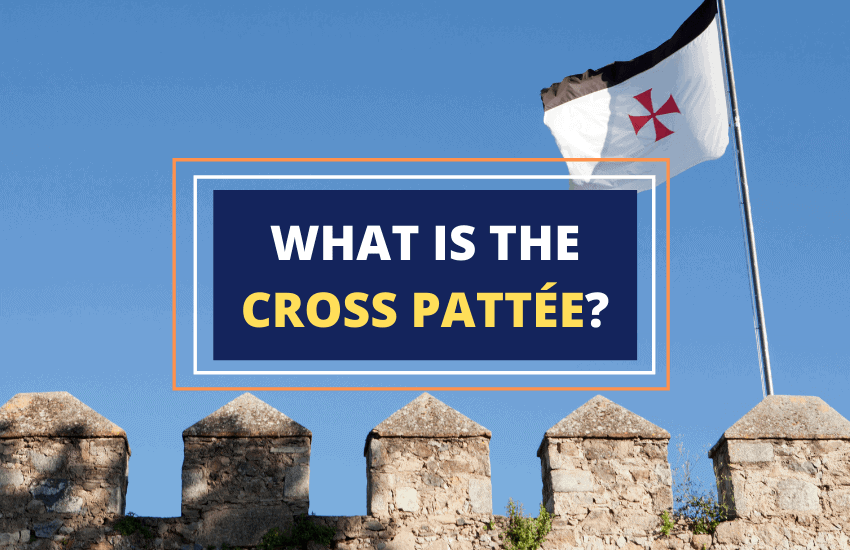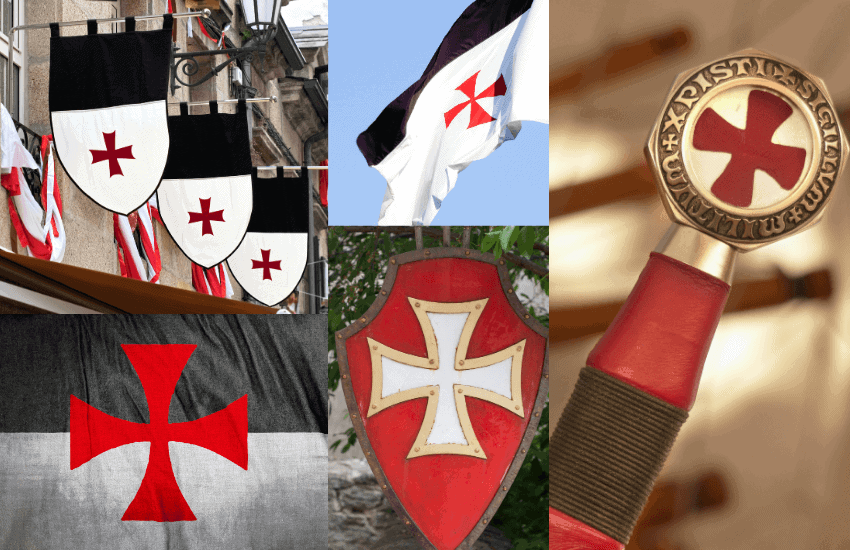
Table of Contents
Sometimes called A cross formy, the cross pattée is recognized for its arms which narrow towards the center and for having broad, flat ends. Here’s a look at the rich history of this variant of the Christian cross, along with its significance in different time periods and symbolic meanings.
Variations of the Cross Pattée

In general, the cross pattée features non-indented ends, but their broadness and narrowness towards the center can vary. Some flare in a straight line, while others feature a curvy shape. Also, some variations might feature triangular arms that come close to filling the square. Some other variations are:
- The so-called Iron Cross was used by the Imperial German Army in 1915 on their Luftstreitkräfte aircraft, and it had concave arms and flat ends.
- The Alisee cross has curved or convex ends instead of flat.
- The Bolnisi cross has narrower arms flaring towards the dented ends.
- In a symbol used by the Portuguese Military Order of Christ, the cross appears more angular than flared, in which its center has straight parallel lines connecting into cornered triangle ends.
Symbolic Meaning of the Cross Pattée
The cross pattée has long been associated with religion, philosophy and the military. Here are some of its meanings:
- A Symbol of Valor – From medieval times to the modern era, the cross pattée has represented honor and dignity. In Britain, the Victoria Cross is the most prestigious award given to the members of the British Armed Forces.
- A Symbol of Nationality – It’s no doubt that the cross pattée is one of the earliest heraldic ensigns. A stylized version of the cross is used by Bundeswehr, a German armed force, as an emblem of nationality, decorating their aircrafts, vehicles and publications.
- A Symbol of Christianity – The cross pattée was first used by the Knights Templars and the Teutonic Knights, which are Christian military orders. The idea that all Crusaders were devout Christians somehow contributed to its significance on today’s emblems of many religious orders.
Also, in Christian symbology, the cross is generally a symbol of sacrifice and salvation.
- However, in some contexts, the symbol can represent hate or rebellion, as it was adopted by certain groups to show their political ideologies, such as the Nazis.
History of the Cross Pattée

The French term pattée is an adjective in the feminine form and derived from the noun patte meaning foot. When used in a context such as la croix pattée, it translates to footed cross. In German, the same cross is referred to as Tatzenkreuz, which is derived from the term tatze meaning paw.
This term comes from an Old French term patu, which refers to the base of a cup, as well as the Latin patens, which means opening or spreading. It’s just fitting for the symbol with four flat ends, reminding us of the foot of a candelabrum or chalice.
The Crusaders and the Cross
The cross pattée reminds us of the Crusades, which were a series of religious wars between Muslims and Christians between 1096 and 1291. The symbol was used as an emblem by the Christian military orders, including the Teutonic Knights and the Knights Templars, which defended the conquests in the Holy Land and protected European travelers visiting the region.
The Templars were recognized by their white robes marked with a red cross. However, there was no specific style of cross given to them, so the cross pattée was just one of the many variations that they adopted. In 1205, Pope Innocent III granted the Teutonic Knights the use of the cross as their emblem. They traditionally wore white robes with a straight black cross, but the cross pattée was also used as their coat of arms.
In Prussia and German Empire
In 1312, the Knights Templars were dissolved as an order. Due to the expansion of Protestantism, the Teutonic Order’s rule in Prussia came to an end by 1525. That also meant that the insignia of a black cross pattée on a white mantle became insignificant. Eventually, the existence of Christian military orders became less relevant even in the northern and Central Europe.
In 1813, the cross pattée became associated with Prussia when King Frederick William III used it as a symbol of military valor. The Iron Cross was a military award for service in the Prussian War of Liberation. Eventually, it was revived by William I—the King of Prussia and the first German Emperor—for the Franco-Prussian War in 1870.
World War I and the Cross Pattée
A cross pattée cap badge was used by the Prussian and German Imperial military, particularly the Landsturm and Landwehr troops to distinguish them from other army. As a German military award, the Iron Crosses were also given until the end of World War I.
The Nazi Regime and the Cross
In 1939, Adolf Hitler, a German politician and leader of the Nazi Party, revived the emblem—but incorporated a swastika symbol at the center of the cross pattée. It was during the World War II when he decreed that the cross should be awarded to those who showed great leadership and exceptional bravery.
In Royal Crowns
In some parts of the world, the cross pattée is commonly seen on many crowns worn by monarchs. Some imperial crowns have detachable half-arches, allowing them to be worn as a circlet. The cross are usually seen on top of the arches, but sometimes there are four crosses on the crown itself.
In Christian countries, the cross pattée, along with precious stones, often decorates the crowns. The symbol also can be seen on the crown of St. Edward of Britain and the Imperial Crown of India in 1911.
The Cross Pattée in Modern Times
The symbol remains widely used in heraldry, as well as in military decorations and emblems of various organizations and religious orders.
1. In Religion
In the Roman Catholic Church, the cross pattée is placed before the name of the bishop who issues authoritative approval for religious publications or other works. Also, it’s commonly seen in the emblems of several Catholic fraternal service orders.
2. In Military
Nowadays, the symbol is commonly used in military decorations and awards. In fact, the Order of Saint George, depicting the cross with a central medallion, is regarded as the highest military decoration of the Russian Federation. The cross pattée can be found on military emblems of Ukraine and other countries.
3. In Flags and Coat of Arms
The cross pattée can be found on coats of arms of various French communes, as well as of various cities in Poland, Spain and Russia. In Sweden, the symbol sometimes refers to the Saint George’s Cross, which appears on flag and emblems of Swedish Freemasons. It’s one of the oldest national symbols of Georgia and appears on the flag of Montenegro.
In Brief
From an insignia of religious orders to a symbol of nationality, the cross pattée remains one of the most popular emblems that find their way in works of heraldry and other insignias of non-religious organizations.








